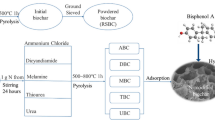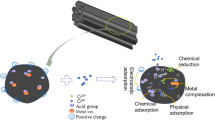Abstract
N-containing biochar from oatmeal was produced by co-pyrolysis of hydrochar, ZnCl2, and FeCl3, showing well-developed pores with surface areas of 2744 m2/g and N species of 5.4 at.%. The as-formed biochar was used for Cr(VI) removal via batch adsorption, and the different parameters, i.e., initial pH, contact time, and concentration on efficiency, were evaluated. Adsorptive results indicated that Cr(VI) removal is largely affected by surface areas and functional groups of biochar under optimum pH value of two, following by pseudo-second-order and Langmuir model. The maximum capacity for Cr(VI) is up to 139 mg/g from synergistic effect of adsorption and reduction mechanism, much higher than that of analogous in the absence of FeCl3 with capacity of 113 mg/g and commercial activated carbons of 61 mg/g. N-containing biochar also had superior recyclability with capacity still up to 67.5 mg/g even after ten times recycling. The inexpensive feedstock and high removal performance made the present biochar be a promising candidate for Cr(VI) removal from wastewater.







Similar content being viewed by others
Data availability
All data within the manuscript.
References
Zheng C, Yang Z, Si M, Zhu F, Yang W, Zhao F, Shi Y (2021) Application of biochars in the remediation of chromium contamination: fabrication, mechanisms, and interfering species. J Hazard Mater 407:124376. https://doi.org/10.1016/j.jhazmat.2020.124376
Qian L, Yan S, Yong X, Selvaraj M, Ghramh HA, Assiri MA et al (2023) Effective degradation of chloramphenicol in wastewater by activated peroxymonosulfate with Fe-rich porous biochar derived from petrochemical sludge. Chemosphere 310:136839. https://doi.org/10.1016/j.chemosphere.2022.136839
Zhou C, Liang Y, Xia W, Almatrafi E, Song B, Wang Z et al (2023) Single atom Mn anchored on N-doped porous carbon derived from spirulina for catalyzed peroxymonosulfate to degradation of emerging organic pollutants. J Hazard Mater 441:129871. https://doi.org/10.1016/j.jhazmat.2022.129871
Hou Y, Liang Y, Hu H, Tao Y, Zhou J, Cai J (2021) Facile preparation of multi-porous biochar from lotus biomass for methyl orange removal: kinetics, isotherms, and regeneration studies. Bioresour Technol 329:124877. https://doi.org/10.1016/j.biortech.2021.124877
Zhou L, Liu Y, Liu S et al (2016) Investigation of the adsorption-reduction mechanisms of hexavalent chromium by ramie biochars of different pyrolytic temperatures. Bioresour Technol 218:351–359. https://doi.org/10.1016/j.biortech.2016.06.102
Hou Z, Luo M, Yang Y, Zhou J, Liu L, Cai J (2021) Algae-based carbons: design, preparation and recent advances in their use in energy storage, catalysis and adsorption. New Carbon Mater 36:278–303. https://doi.org/10.1016/S1872-5805(21)60020-3
Luo L, Cheng S, Yue L, You Z, Cai J (2022) N-doped biochar from chitosan gel-like solution: effect of hydrothermal temperature and superior aqueous Cr (VI) removal performance. Colloids Surf A Physicochem Eng Asp 641:128426. https://doi.org/10.1016/j.colsurfa.2022.128426
El Nemr A, Aboughaly RM, El Sikaily A, Ragab S, Masoud MS, Ramadan MS (2022) Microporous nano-activated carbon type I derived from orange peel and its application for Cr(VI) removal from aquatic environment. Biomass Conver Bior 12:5125–5143. https://doi.org/10.1007/s13399-020-00995-5
Wang J, Liu P, Lai F, Huang H (2020) Pyrolysis of different sewage sludge feedstocks for biochar products: characterization and application. J Cent South Univ 27:3302–3319. https://doi.org/10.1007/s11771-020-4548-y
Wang Y, Wang XJ, Liu M et al (2012) Cr(VI) removal from water using cobalt-coated bamboo charcoal prepared with microwave heating. Ind Crop Prod 39:81–88. https://doi.org/10.1016/j.indcrop.2012.02.015
Ramola S, Belwal T, Li C et al (2020) Improved lead removal from aqueous solution using novel porous bentonite - and calcite-biochar composite. Sci Total Environ 709:136171. https://doi.org/10.1016/j.scitotenv.2019.136171
Wang F, Liu L, Liu F, Wang L, Ouyang T, Chang C (2017) Facile one-step synthesis of magnetically modified biochar with enhanced removal capacity for hexavalent chromium from aqueous solution. J Taiwan Inst Chem Eng 81:414–418. https://doi.org/10.1016/j.jtice.2017.09.035
Poo KM, Son EB, Chang JS, Ren X, Choi YJ, Chae KJ (2018) Biochars derived from wasted marine macro-algae (Saccharina japonica and Sargassum fusiforme) and their potential for heavy metal removal in aqueous solution. J Environ Manag 206:364–372. https://doi.org/10.1016/j.jenvman.2017.10.056
Shi Y, Zheng W, Liu H, Wang L, Zhang H (2019) Protein-derived nitrogen and sulfur co-doped carbon for efficient adsorptive removal of heavy metals. Chin J Chem Eng 27:2581–2586. https://doi.org/10.1016/j.cjche.2018.11.017
Hou Y, Yan S, Huang G, Yang Q, Huang S, Cai J (2020) Fabrication of N-doped carbons from waste bamboo shoot shell with high removal efficiency of organic dyes from water. Bioresour Technol 303:122939. https://doi.org/10.1016/j.biortech.2020.122939
Jain A, Jayaraman S, Balasubramanian R, Srinivasan MP (2014) Hydrothermal pre-treatment for mesoporous carbon synthesis: enhancement of chemical activation. J Mater Chem A 2:520–528. https://doi.org/10.1039/C3TA12648J
Ding K, Zhou X, Hadiatullah H et al (2021) Removal performance and mechanisms of toxic hexavalent chromium (Cr(VI)) with ZnCl2 enhanced acidic vinegar residue biochar. J Hazard Mater 420:126551. https://doi.org/10.1016/j.jhazmat.2021.126551
Ma Y, Qi Q, Lu T et al (2021) Highly efficient removal of imidacloprid using potassium hydroxide activated magnetic microporous loofah sponge biochar. Sci Total Environ 765:144253. https://doi.org/10.1016/j.scitotenv.2020.144253
Ma Y, Li M, Li P et al (2021) Hydrothermal synthesis of magnetic sludge biochar for tetracycline and ciprofloxacin adsorptive removal. Bioresour Technol 319:124199. https://doi.org/10.1016/j.biortech.2020.124199
Cheng H, Ji R, Bian Y, Jiang X, Song Y (2020) From macroalgae to porous graphitized nitrogen-doped biochars – using aquatic biota to treat polycyclic aromatic hydrocarbons-contaminated water. Bioresour Technol 303:122947. https://doi.org/10.1016/j.biortech.2020.122947
Thue PS, Umpierres CS, Lima EC (2020) Single-step pyrolysis for producing magnetic activated carbon from tucuma (Astrocaryum aculeatum) seed and nickel(II) chloride and zinc(II) chloride. Application for removal of nicotinamide and propanolol. J Hazard Mater 398:122903. https://doi.org/10.1016/j.jhazmat.2020.122903
Yan D, Yu C, Zhang X et al (2016) Nitrogen-doped carbon microspheres derived from oatmeal as high capacity and superior long life anode material for sodium ion battery. Electrochim Acta 191:385–391. https://doi.org/10.1016/j.electacta.2016.01.105
Liang Y, Huang G, Zhang Q, Yang Y, Zhou J, Cai J (2021) Hierarchical porous carbons from biowaste: hydrothermal carbonization and high-performance for Rhodamine B adsorptive removal. J Mol Liq 330:115580. https://doi.org/10.1016/j.molliq.2021.115580
Nasrullah A, Saad B, Bhat AH et al (2019) Mangosteen peel waste as a sustainable precursor for high surface area mesoporous activated carbon: characterization and application for methylene blue removal. J Clean Prod 211:1190–1200. https://doi.org/10.1016/j.jclepro.2018.11.094
Zhou L, Zhang G, Wang M, Wang D, Cai D, Wu Z (2018) Efficient removal of hexavalent chromium from water and soil using magnetic ceramsite coated by functionalized nano carbon spheres. Chem Eng J 334:400–409. https://doi.org/10.1016/j.cej.2017.10.065
Liang S, Shi S, Zhang H et al (2019) One-pot solvothermal synthesis of magnetic biochar from waste biomass: formation mechanism and efficient adsorption of Cr(VI) in an aqueous solution. Sci Total Environ 695:133886. https://doi.org/10.1016/j.scitotenv.2019.133886
He Y, Alhassan SI, Zhang W et al (2021) Electrochemically-mediated capture and reduction of Cr(VI) by highly porous N-doped carbon spheres. J Environ Chem Eng 9:106067. https://doi.org/10.1016/j.jece.2021.106067
Norouzi S, Heidari M, Alipour V et al (2018) Preparation, characterization and Cr(VI) adsorption evaluation of NaOH-activated carbon produced from Date Press Cake; an agro-industrial waste. Bioresour Technol 258:48–56. https://doi.org/10.1016/j.biortech.2018.02.106
Herath A, Layne CA, Perez F et al (2021) KOH-activated high surface area Douglas Fir biochar for adsorbing aqueous Cr(VI), Pb(II) and Cd(II). Chemosphere 269:128409. https://doi.org/10.1016/j.chemosphere.2020.128409
Vo AT, Nguyen VP, Ouakouak A et al (2019) Efficient removal of Cr(VI) from water by biochar and activated carbon prepared through hydrothermal carbonization and pyrolysis: adsorption-coupled reduction mechanism. Water 11:1164. https://doi.org/10.3390/w11061164
Ghadikolaei NF, Kowsari E, Balou S, Moradi A, Taromi FA (2019) Preparation of porous biomass-derived hydrothermal carbon modified with terminal amino hyperbranched polymer for prominent Cr(VI) removal from water. Bioresour Technol 288:121545. https://doi.org/10.1016/j.biortech.2019.121545
Dong L, Liang J, Li Y et al (2018) Effect of coexisting ions on Cr(VI) adsorption onto surfactant modified Auricularia auricula spent substrate in aqueous solution. Ecotoxicol Environ Saf 166:390–400. https://doi.org/10.1016/j.ecoenv.2018.09.097
Gupta GK, Mondal MK (2023) Mechanism of Cr(VI) uptake onto sagwan sawdust derived biochar and statistical optimization via response surface methodology. Biomass Conver Bioref 13:709–725. https://doi.org/10.1007/s13399-020-01082-5
Chen S, Wang J, Wu Z et al (2018) Enhanced Cr(VI) removal by polyethylenimine- and phosphorus-codoped hierarchical porous carbons. J Colloid Interface Sci 523:110–120. https://doi.org/10.1016/j.jcis.2018.03.057
Funding
This study received financial supports from Education Bureau of Hunan Province (21B0098), Project of Guiding Technology of Xiangtan City (CG-ZDJH202120), and Undergraduate Innovation and Entrepreneurship Training Project of Xiangtan University.
Author information
Authors and Affiliations
Contributions
Zhikang Zhou: conceptualization, methodology, investigation, and writing
Yu Bu: writing and visualization
Xinglin Long: methodology and investigation
Jinjun Cai: methodology, modification, and supervision
Corresponding author
Ethics declarations
Ethical approval
Not applicable.
Competing interests
The authors declare no competing interests.
Consent to participate
Not applicable.
Consent for publication
Not applicable.
Additional information
Publisher’s note
Springer Nature remains neutral with regard to jurisdictional claims in published maps and institutional affiliations.
Supplementary information
ESM 1
Supplementary data associated with this article can be found, in the online version, at https://doi.org/10.1016/2023. (DOCX 1642 kb)
Rights and permissions
Springer Nature or its licensor (e.g. a society or other partner) holds exclusive rights to this article under a publishing agreement with the author(s) or other rightsholder(s); author self-archiving of the accepted manuscript version of this article is solely governed by the terms of such publishing agreement and applicable law.
About this article
Cite this article
Zhou, Z., Bu, Y., Long, X. et al. N-containing biochar from oatmeal: hydrothermal synthesis and used as highly efficient adsorbent for Cr(VI) adsorptive-reduction removal. Biomass Conv. Bioref. (2023). https://doi.org/10.1007/s13399-023-03955-x
Received:
Revised:
Accepted:
Published:
DOI: https://doi.org/10.1007/s13399-023-03955-x




